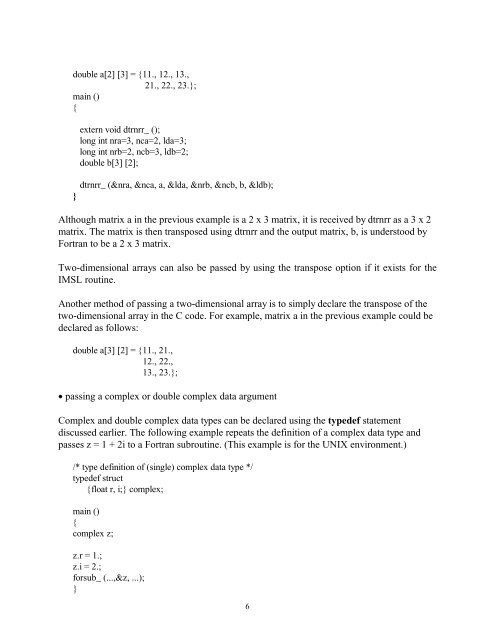HOW TO CALL THE IMSL FORTRAN LIBRARIES FROM C by ...
HOW TO CALL THE IMSL FORTRAN LIBRARIES FROM C by ...
HOW TO CALL THE IMSL FORTRAN LIBRARIES FROM C by ...
Create successful ePaper yourself
Turn your PDF publications into a flip-book with our unique Google optimized e-Paper software.
double a[2] [3] = {11., 12., 13.,<br />
21., 22., 23.};<br />
main ()<br />
{<br />
extern void dtrnrr_ ();<br />
long int nra=3, nca=2, lda=3;<br />
long int nrb=2, ncb=3, ldb=2;<br />
double b[3] [2];<br />
}<br />
dtrnrr_ (&nra, &nca, a, &lda, &nrb, &ncb, b, &ldb);<br />
Although matrix a in the previous example is a 2x3matrix,itisreceived <strong>by</strong> dtrnrr as a 3 x 2<br />
matrix. The matrix is then transposed using dtrnrr and the output matrix, b, is understood <strong>by</strong><br />
Fortrantobea2x3matrix.<br />
Two-dimensional arrays can also be passed <strong>by</strong> using the transpose option if it exists for the<br />
<strong>IMSL</strong> routine.<br />
Another method of passing a two-dimensional array is to simply declare the transpose of the<br />
two-dimensional array in the C code. For example, matrix a in the previous example could be<br />
declared as follows:<br />
double a[3] [2] = {11., 21.,<br />
12., 22.,<br />
13., 23.};<br />
• passing a complex or double complex data argument<br />
Complex and double complex data types can be declared using the typedef statement<br />
discussed earlier. The following example repeats the definition of a complex data type and<br />
passes z = 1 + 2i to a Fortran subroutine. (This example is for the UNIX environment.)<br />
/* type definition of (single) complex data type */<br />
typedef struct<br />
{float r, i;} complex;<br />
main ()<br />
{<br />
complex z;<br />
z.r = 1.;<br />
z.i = 2.;<br />
forsub_ (...,&z, ...);<br />
}<br />
6
















